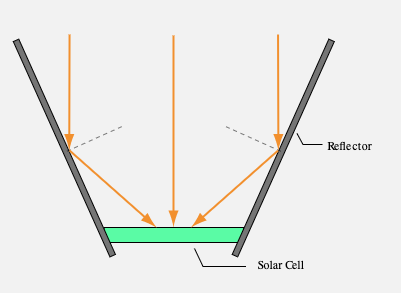

How can we help you today?
Concentrated PV
What is concentrating photovoltaics?
Most of us are aware of standard solar panels that generate electricity from the sun but another way to increase the output from the photovoltaic systems is to supply concentrated light onto PV cells.
This can be done by using optical light collectors such as lenses or mirrors.
The CPV collects light from a larger area and concentrates it to a smaller area super efficient solar cell.
Concentration categories
In general, the CPV can be classified into three different categories which are: Low-concentration, Medium-concentration and High-concentration.
This concentration is expressed in the number of "suns". E.g. "3x" means that the intensity of the light that hits the photovoltaic material is 3 x times more than it would be without concentration.
What methods of concentration are used?
Concentrator technologies are either line or point and generally fall into the following categories: Fresnel Lens, Parabolic Mirrors and Reflectors
Fresnel Lens

The Fresnel lens was named after the French physicist. It comprises sections of glass with different angles, which reduces the weight and thickness in comparison to a normal lens.
Possible to achieve short focal length and large aperture while keeping the lens light.
Parabolic Mirrors

In the case of the Parabolic mirror method all incoming parallel light is reflected by the collector (the first mirror) through a focal point onto a second mirror.
This second mirror, which is much smaller, is also a parabolic mirror with the same focal point.
It reflects the light beams to the middle of the first parabolic mirror where it hits the super efficient solar cell.
Reflectors

In this case low concentration photovoltaic modules use mirrors to concentrate sunlight onto a standard solar cell. This technique lowers the reflection losses by effectively providing a second internal mirror.
What kinds of material are used for the panels?
There are both lower and higher efficiency CPV technologies that may use:
- Silicon
- CdTe ( Cadmium telluride )and
- CIGS (copper indium gallium selenide) cells
But the highest efficiencies are achieved with multi-junction cells with multiple p–n junctions made of different semiconductor materials.
Each material's p-n junction will produce electric current in response to different wavelengths of light which allows the absorbance of a broader range of wavelengths, improving the cell's sunlight to electrical energy conversion efficiency.
What are the best locations for CPV?
The CPV can only use direct beam radiation and cannot use diffuse radiation (diffused from clouds and atmosphere) so these systems are best suited for areas with high direct normal irradiance.
For proper light concentration, sun tracking is needed to achieve high cell performance and tracking is especially critical for high concentration systems.
What about temperature?
As CPV systems produce increased temperature on the surface of the PV material, energy has to be distributed evenly over the cell area to avoid local overheating (hot spots) which can damage the PV material
Efficiency of the photovoltaic conversion is less at elevated temperatures and this happens with standard PV systems but this is substantially increased due to the much higher temperatures involved and therefore cooling may be beneficial.
This cooling can be active or passive.
For the CPV cells with low and medium concentration ratios, active cooling is not necessary, since the temperatures reached are moderate. The high-concentration cells require high-capacity heat sinks to avoid thermal destruction of the materials.
Cooling

With passive cooling the cell is placed on a cladded ceramic substrate with high thermal conductivity and the ceramic also provides electrical isolation.
Active Cooling, on the other hand, typically uses liquid metal as a cooling fluid, capable of cooling from 1,700°C to 100°C.
Concentration, materials, cooling, tracking
In the table below I have outlined the three different concentration categories, the PV material utilized and the tracking requirements.

What are the advantages of CPV?
The advantage is that these systems require less photovoltaic material to capture the same sunlight as non-concentrating pv and this makes the use of expensive multi-junction cells viable due to smaller space requirements.
Concentrating light, however, requires direct sunlight rather than diffuse light, limiting this technology to clear, sunny locations. It also means that, in most/all instances, tracking is required.
Pros and cons

Conclusion
Concentrated PV increases the amount of usable light hitting a photovoltaic cell and depending on the level of concentration required, different cell materials are utilized.
Concentration can be achieved by a variety of methods; fresnel lens, parabolic mirrors, reflectors and the best locations have a high level of direct irradiation for the majority of time.
If you’d like to see more of what Greenwood Solutions get up to in the real world of renewable energy, solar, battery storage and grid protection check out the following pages:
https://www.greenwoodsolutions.com.au/industry
https://www.greenwoodsolutions.com.au/commercial
https://www.greenwoodsolutions.com.au/commercial/customer-stories
https://www.greenwoodsolutions.com.au/news

About the author
Veli Markovic
CEC Designer
Training videos
Every week we publish new videos and walkthroughs online.









